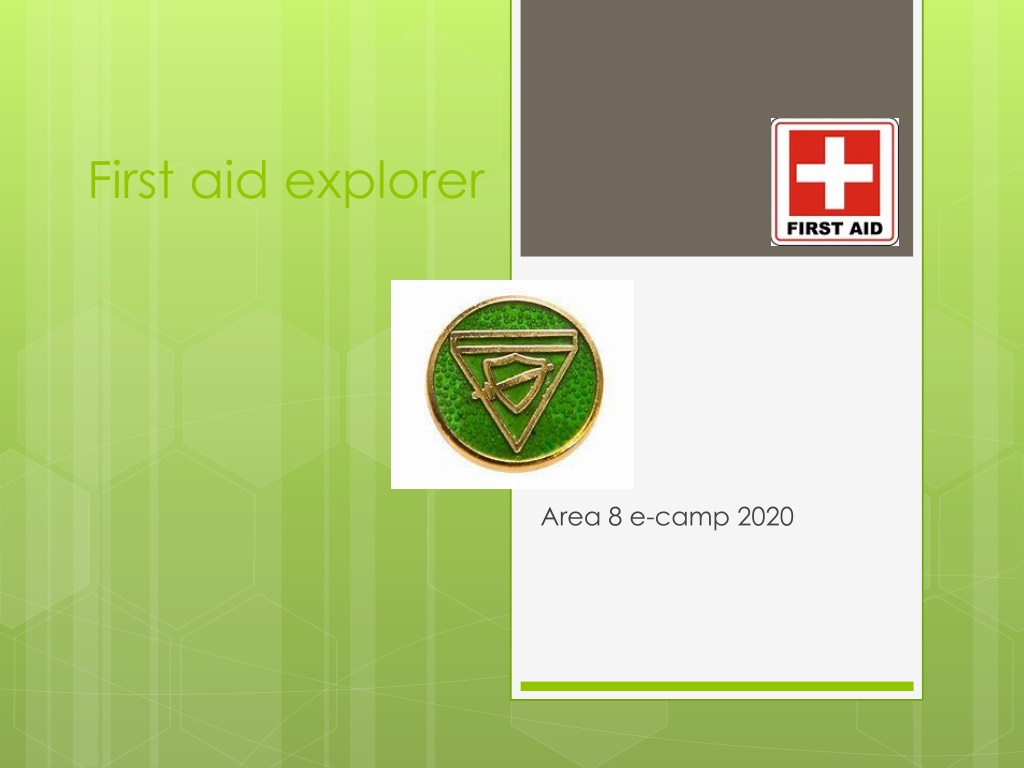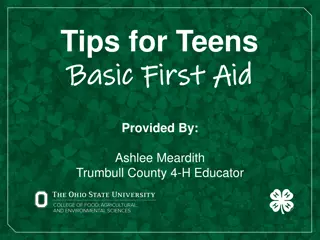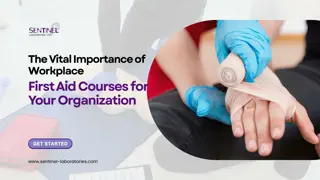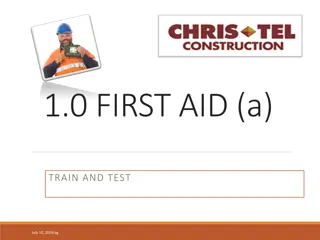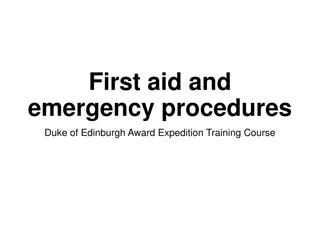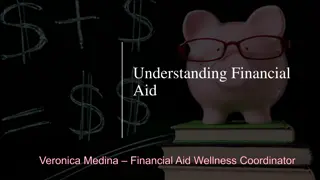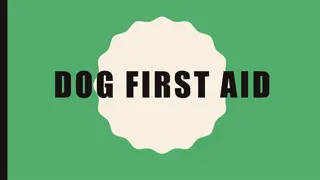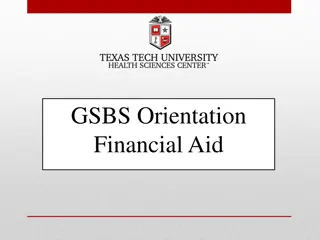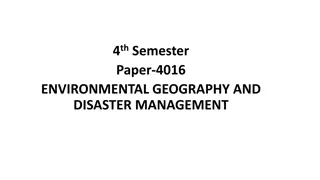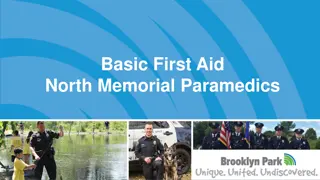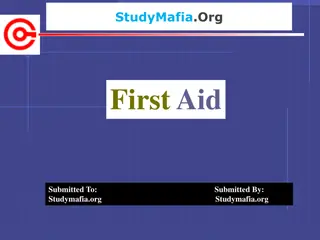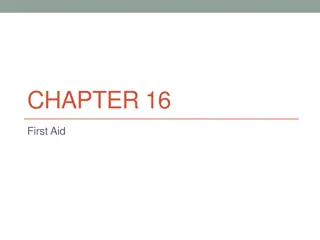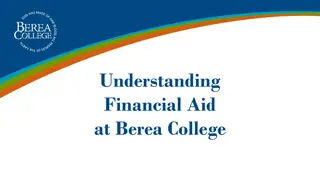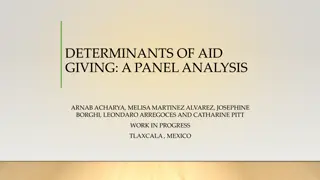First Aid Guide for Common Emergencies
Learn how to treat common injuries and emergencies at home using simple solutions and when to seek professional help. Topics covered include sunburn, burns, smoke exposure, and handling unconsciousness.
Download Presentation

Please find below an Image/Link to download the presentation.
The content on the website is provided AS IS for your information and personal use only. It may not be sold, licensed, or shared on other websites without obtaining consent from the author. Download presentation by click this link. If you encounter any issues during the download, it is possible that the publisher has removed the file from their server.
E N D
Presentation Transcript
First aid explorer Area 8 e-camp 2020
SUNBURN Sunburn can be treated at home with: Cool compresses Over-the-counter pain medications, Aloe vera gel or lotion Hydration - drinking plenty of fluids
BURNS The term burn means more than the burning sensation associated with this injury. Burns are characterized by severe skin damage that causes the affected skin cells to die.
SMOKE IN THE EYES Over-the-counter artificial tears. Cool your eyes. Stay indoors. Wear glasses or goggles. Improve your indoor air with an air filter.
SMOKE INHAILATION Signs and symptoms of smoke inhalation : Cough and hoarseness Chest pain or coughing up blood Trouble breathing, such as shortness of breath and noisy breathing Headache, abdominal pain, and nausea Eye irritation or vision problems Fainting Soot in your nostrils or throat
SMOKE INHAILATION How is smoke inhalation treated? Antidotes: These are substances that may stop or control the effects of the smoke you inhaled. Healthcare providers may give different antidotes depending on the type of smoke you inhaled. Bronchodilators: Steroids: Steroid medicine may help to open your air passages so you can breathe easier. Antibiotics: This medicine is given to help treat or prevent an infection caused by bacteria. Medicines to treat pain, swelling, or fever:
UNCONCIOUSNESS Unconsciousness is when a person suddenly becomes unable to respond to stimuli and appears to be asleep. A person may be unconscious for a few seconds as in fainting or for longer periods of time. Common causes of unconsciousness include: A car accident Severe blood loss A blow to the chest or head A drug overdose Alcohol poisoning
UNCONCIOUSNESS Check whether the person is breathing. If they re not breathing, have someone call 911 or your local emergency services immediately and prepare to begin CPR. If they re breathing, position the person on their back. Raise their legs at least 12 inches above the ground. Loosen any restrictive clothing or belts. If they don t regain consciousness within one minute, call 911 or your local emergency services. Check their airway to make sure there s no obstruction. Check again to see if they re breathing, coughing, or moving. These are signs of positive circulation. If these signs are absent, perform CPR until emergency personnel arrive. If there s major bleeding occurring, place direct pressure on the bleeding area or apply a tourniquet above the bleeding area until expert help arrives.
CPR How do you perform CPR? CPR is a way to treat someone when they stop breathing or their heart stops beating. If a person stops breathing, call your local emergency services or ask someone else to. Before beginning CPR, ask loudly, Are you OK? If the person doesn t respond, begin CPR. Lay the person on their back on a firm surface. Kneel next to their neck and shoulders. Place the heel of your hand over the center of their chest. Put your other hand directly over the first one and interlace your fingers. Make sure that your elbows are straight and move your shoulders up above your hands. Using your upper body weight, push straight down on their chest at least 1.5 inches for children or 2 inches for adults. Then release the pressure. Repeat this procedure again up to 100 times per minute. These are called chest compressions. To minimize potential injuries, only those trained in CPR should perform rescue breathing. If you haven t been trained, perform chest compressions until medical help arrives. If you re trained in CPR, tilt the person s head back and lift the chin to open up the airway. Pinch the person s nose closed and cover their mouth with yours, creating an airtight seal. Give two one-second breaths and watch for their chest to rise. Continue alternating between compressions and breaths 30 compressions and two breaths until help arrives or there are signs of movement.
CONSTRICTIONS AND RESTRICTIVE BANDAGES Constrictive bandage Dressing applied to restrict joint movement, prevent oedema formation or control bleeding Bandage is a piece of material used either to support a medical device such as a dressing or splint, or on its own to provide support to or to restrict the movement of a part of the body. When used with a dressing, the dressing is applied directly on a wound, and a bandage used to hold the dressing in place.
. SNAKE BITE Some snakes are venomous and can inject venom containing toxins as they bite. A bite from a venomous snake is a medical emergency because it can be deadly if not treated quickly
SNAKE BITE What to do after a snake bite Immediately after being bitten by a snake you should: remain calm and don't panic snake bites, particularly those that occur in the UK, usually aren't serious and are only very rarely deadly try to remember the shape, size and colour of the snake keep the part of your body that's been bitten as still as possible to prevent the venom spreading around your body remove jewellery and watches from the bitten limb as they could cut into your skin if the limb swells do not attempt to remove any clothing, but loosen clothing if possible seek immediate medical attention If you or someone you're with is bitten by a snake, you should NOT: try to suck the venom out of the bite try to cut the venom out of the bite or make it bleed rub anything into the wound or apply ice, heat or chemicals leave someone who's been bitten on their own put anything around the bitten limb to stop the spread of venom (such as a tight pressure band, tourniquet or ligature) as it won't help, and can cause swelling or make it worse; it could also damage the limb, leading to the need for amputation try to catch or kill the snake
BITES AND STINGS A wasp or hornet sting causes a sudden, sharp pain at first. A swollen red mark may then form on your skin, which can last a few hours and may be painful and itchy. Sometimes a larger area around the sting can be painful, red and swollen for up to a week. This is a minor allergic reaction that isn't usually anything to worry about. A few people may experience a serious allergic reaction (anaphylaxis), difficulties, dizziness and a swollen face or mouth. Dial 999 immediately if you have these symptoms. causing breathing for an ambulance
BEE STING Bee sting feels similar to a wasp sting, but the sting will often be left in the wound. See treating insect bites for advice about how to remove this safely. The sting can cause pain, redness and swelling for a few hours. As with wasp stings, some people may have a mild allergic reaction that lasts up to a week. Serious allergic reactions can also occasionally occur, causing breathing difficulties, dizziness and a swollen face or mouth. Dial 999 for an ambulance immediately if you have these symptoms.
MOSQUITO BITE Bites from mosquitoes often cause small red lumps on your skin. These are usually very itchy. Some people may also develop fluid-filled blisters. Mosquitoes don't cause major harm in the UK, but in some parts of the world they can spread serious illnesses such as malaria. Get medical help right away if you develop worrying symptoms, such as a fever, vomiting, after a mosquito bite abroad. chills, headaches and
EXPLOSURE TO COLD CONDITIONS FROSTBITE First aid for frostbite, as well as immersion or trench foot, includes: Check for signs of hypothermia and seek medical attention. If necessary quickly transport the victim to an emergency care facility. Treat the person gently and monitor breathing. If possible, move the victim to a warm area. Remove wet clothing, and gently loosen or remove constricting clothing or jewellery that may restrict circulation. Warm the person by wrapping them in blankets or by them putting on dry clothing. Cover the head and neck. Warm the person slowly. Avoid direct heat which can burn the skin. Loosley cover the affected area with a sterile dressing. Place some gauze between fingers and toes to absorb moisture and prevent them from sticking together. If the person is alert, give them warm liquids to drink. DO NOT attempt to rewarm the affected frostbite area on site (but do try to stop the area from becoming any colder) - without the proper medical care, tissue that has been warmed may refreeze and cause more damage. DO NOT rub area or apply dry heat. DO NOT allow the victim to drink alcohol or smoke.
THANKYOU God bless
